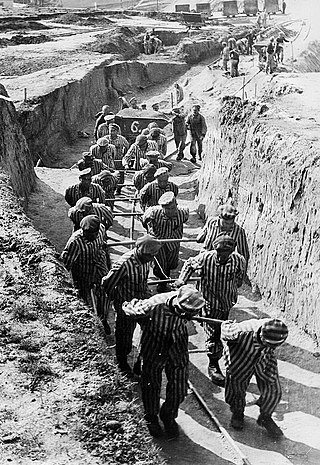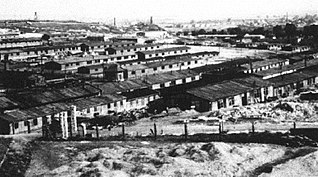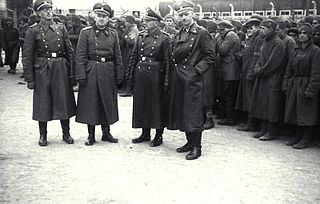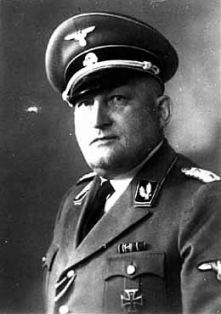
Buchenwald was a Nazi concentration camp established on Ettersberg hill near Weimar, Germany, in July 1937. It was one of the first and the largest of the concentration camps within Germany's 1937 borders. Many actual or suspected communists were among the first internees.

Neuengamme was a network of Nazi concentration camps in Northern Germany that consisted of the main camp, Neuengamme, and more than 85 satellite camps. Established in 1938 near the village of Neuengamme in the Bergedorf district of Hamburg, the Neuengamme camp became the largest concentration camp in Northwest Germany. Over 100,000 prisoners came through Neuengamme and its subcamps, 24 of which were for women. The verified death toll is 42,900: 14,000 in the main camp, 12,800 in the subcamps, and 16,100 in the death marches and bombings during the final weeks of World War II. Following Germany's defeat in 1945, the British Army used the site as an internment camp for SS and other Nazi officials. In 1948, the British transferred the land to the Free Hanseatic City of Hamburg, which summarily demolished the camp's wooden barracks and built in its stead a prison cell block, converting the former concentration camp site into two state prisons operated by the Hamburg authorities from 1950 to 2004. Following protests by various groups of survivors and allies, the site now serves as a memorial. It is situated 15 km southeast of the centre of Hamburg.

Mauthausen was a Nazi concentration camp on a hill above the market town of Mauthausen, Upper Austria. It was the main camp of a group with nearly 100 further subcamps located throughout Austria and southern Germany. The three Gusen concentration camps in and around the village of St Georgen/Gusen, just a few kilometres from Mauthausen, held a significant proportion of prisoners within the camp complex, at times exceeding the number of prisoners at the Mauthausen main camp.

A labor camp or work camp is a detention facility where inmates are forced to engage in penal labor as a form of punishment. Labor camps have many common aspects with slavery and with prisons. Conditions at labor camps vary widely depending on the operators. Convention no. 105 of the United Nations International Labour Organization (ILO), adopted internationally on 27 June 1957, abolished camps of forced labor.

Stutthof was a Nazi concentration camp established by Nazi Germany in a secluded, marshy, and wooded area near the village of Stutthof 34 km (21 mi) east of the city of Danzig (Gdańsk) in the territory of the German-annexed Free City of Danzig. The camp was set up around existing structures after the invasion of Poland in World War II and initially used for the imprisonment of Polish leaders and intelligentsia. The actual barracks were built the following year by prisoners. Most of the infrastructure of the concentration camp was either destroyed or dismantled shortly after the war. In 1962, the former concentration camp with its remaining structures, was turned into a memorial museum.

Gross-Rosen was a network of Nazi concentration camps built and operated by Nazi Germany during World War II. The main camp was located in the German village of Gross-Rosen, now the modern-day Rogoźnica in Lower Silesian Voivodeship, Poland; directly on the rail-line between the towns of Jawor (Jauer) and Strzegom (Striegau). Its prisoners were mostly Jews, Poles and Soviet citizens.

Mittelbau-Dora was a Nazi concentration camp located near Nordhausen in Thuringia, Germany. It was established in late summer 1943 as a subcamp of Buchenwald concentration camp, supplying slave labour from many Eastern countries occupied by Germany, for extending the nearby tunnels in the Kohnstein and for manufacturing the V-2 rocket and the V-1 flying bomb. In the summer of 1944, Mittelbau became an independent concentration camp with numerous subcamps of its own. In 1945, most of the surviving inmates were sent on death marches or crammed in trains of box-cars by the SS. On 11 April 1945, US troops freed the remaining prisoners.

From 1933 to 1945, Nazi Germany operated more than a thousand concentration camps on its own territory and in parts of German-occupied Europe.

Płaszów or Kraków-Płaszów was a Nazi concentration camp operated by the SS in Płaszów, a southern suburb of Kraków, in the General Governorate of German-occupied Poland. Most of the prisoners were Polish Jews who were targeted for destruction by Nazi Germany during the Holocaust. Many prisoners died because of executions, forced labor, and the poor conditions in the camp. The camp was evacuated in January 1945, before the Red Army's liberation of the area on 20 January.

Sachsenhausen or Sachsenhausen-Oranienburg was a German Nazi concentration camp in Oranienburg, Germany, used from 1936 until April 1945, shortly before the defeat of Nazi Germany in May later that year. It mainly held political prisoners throughout World War II. Prominent prisoners included Joseph Stalin's oldest son, Yakov Dzhugashvili; assassin Herschel Grynszpan; Paul Reynaud, the penultimate Prime Minister of France; Francisco Largo Caballero, Prime Minister of the Second Spanish Republic during the Spanish Civil War; the wife and children of the Crown Prince of Bavaria; Ukrainian nationalist leader Stepan Bandera; and several enemy soldiers and political dissidents.

SS-Totenkopfverbände was the Schutzstaffel (SS) organization responsible for administering the Nazi concentration camps and extermination camps for Nazi Germany, among similar duties. While the Totenkopf was the universal cap badge of the SS, the SS-TV also wore this insignia on the right collar tab to distinguish itself from other SS formations.

Richard Glücks was a high-ranking German Nazi official in the SS. From November 1939 until the end of World War II, he was Concentration Camps Inspector (CCI), which became Amt D: Konzentrationslagerwesen under the WVHA in Nazi Germany. As a direct subordinate of Heinrich Himmler, he was responsible for the forced labour of the camp inmates, and was also the supervisor for the medical practices in the camps, ranging from human experimentation to the implementation of the "Final Solution", in particular the mass murder of inmates with Zyklon B gas. After Germany capitulated, Glücks committed suicide by swallowing a potassium cyanide capsule.

Extermination through labour is a term that was adopted to describe forced labor in Nazi concentration camps in light of the high mortality rate and poor conditions; in some camps a majority of prisoners died within a few months. In the 21st century, research has questioned whether there was a general policy of extermination through labor in the Nazi concentration camp system because of widely varying conditions between camps. German historian Jens-Christian Wagner argues that the camp system involved the exploitation of forced labor of some prisoners and the systematic murder of others, especially Jews, with only limited overlap between these two groups.

The Soldau concentration camp established by Nazi Germany during World War II was a concentration camp for Polish and Jewish prisoners. It was located in Działdowo, a town in north-eastern Poland, which after the Nazi-Soviet invasion of Poland in September 1939 was annexed into the Province of East Prussia.

The Alderney camps were prison camps built and operated by Nazi Germany during its World War II occupation of the Channel Islands. The Channel Islands were the only part of the British Isles to be occupied.

In World War II, Nazi Germany established brothels in the concentration camps (Lagerbordell) to create an incentive for prisoners to collaborate, although these institutions were used mostly by Kapos, "prisoner functionaries" and the criminal element, because regular inmates, penniless and emaciated, were usually too debilitated and wary of exposure to Schutzstaffel (SS) schemes. In the end, the camp brothels did not produce any noticeable increase in the prisoners' work productivity levels, but instead, created a market for coupons among the camp VIPs.

The Concentration Camps Inspectorate (CCI) or in German, IKL was the central SS administrative and managerial authority for the concentration camps of the Third Reich. Created by Theodor Eicke, it was originally known as the "General Inspection of the Enhanced SS-Totenkopfstandarten", after Eicke's position in the SS. It was later integrated into the SS Main Economic and Administrative Office as "Amt D".

Action 14f13, also called Sonderbehandlung14f13 and Aktion 14f13, was a campaign by Nazi Germany to murder Nazi concentration camp prisoners. Also called invalid or prisoner euthanasia, the sick, the elderly and those prisoners who were no longer deemed fit for work were separated from the rest of the prisoners during a selection process, after which they were murdered. The Nazi campaign was in operation from 1941 to 1944 and later covered other groups of concentration camp prisoners.

Ravensbrück was a German concentration camp exclusively for women from 1939 to 1945, located in northern Germany, 90 km (56 mi) north of Berlin at a site near the village of Ravensbrück. The camp memorial's estimated figure of 132,000 women who were in the camp during the war includes about 48,500 from Poland, 28,000 from the Soviet Union, almost 24,000 from Germany and Austria, nearly 8,000 from France, and thousands from other countries including a few from the United Kingdom and the United States. More than 20,000 of the total were Jewish. Eighty-five percent were from other races and cultures. More than 80% were political prisoners. Many prisoners were employed as slave labor by Siemens & Halske. From 1942 to 1945, the Nazis undertook medical experiments to test the effectiveness of sulfonamides.

Forced labor was an important and ubiquitous aspect of the Nazi concentration camps which operated in Nazi Germany and German-occupied Europe between 1933 and 1945. It was the harshest and most inhumane part of a larger system of forced labor in Nazi Germany.



















